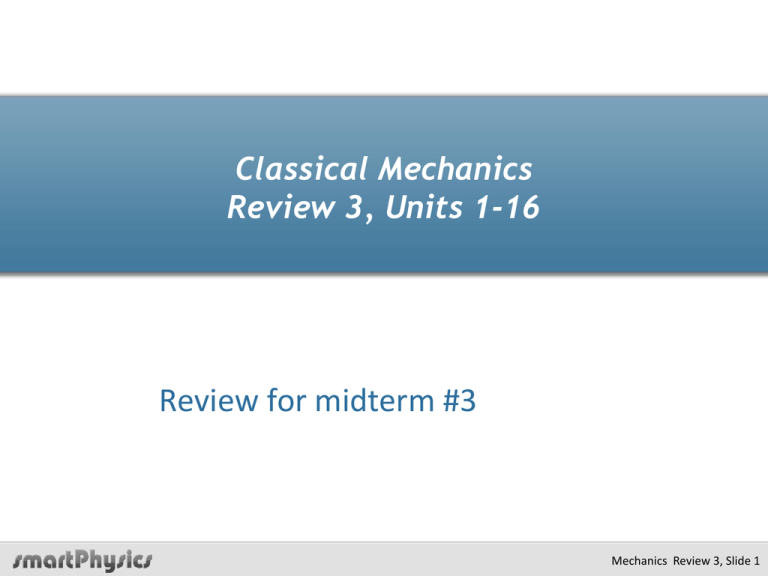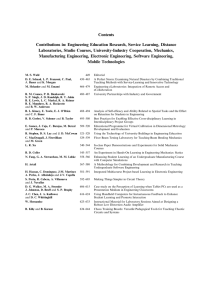Review for midterm #3 Classical Mechanics Review 3, Units 1-16
advertisement

Classical Mechanics Review 3, Units 1-16 Review for midterm #3 Mechanics Review 3, Slide 1 Important Equations 1 mi vi M FNet , Ext M 1 Center of mass rCM mi ri vCM aCM M Collisions Elastic Collisions: PTotal 0 and KTotal 0 v1,i - v2,i - (v1, f - v2, f) Inelastic Collisions: PTotal 0 but K Total 0 m1v1i m2v2i vCM PTotal 0 v f Perfectly Inelastic Collisions: m1 m2 p F t F dt Impulse of a Force avg Rigid Bodies 2 Moment of Inertia: I Axis mi ri Torque: r F = rF sin Dynamics: FNet , Ext MaCM and τNet Iα Relations Between Angular and Linear Quantities: s R , v R , at R Parallel Axis Theorem: IAxis = ICM + MD2 Rolling Motion: xcm = Rq, vcm = Rw, acm = Ra Mechanics Review 3, Slide 2 Example: Elastic Collision in 1D Two masses approach each other with equal and opposite velocities as measured in the lab reference frame. The mass moving to the right is twice as massive as the one moving to the left. The collision between them is elastic. What is the velocity of the center of mass before the collision? What is the velocity of the center of mass after the collision? What are the velocities of the two objects after the collision? V1 = 1 m/s V2 = -1 m/s g M m1v1i + m2 v2i vcm,i = = vcm, f m1 + m2 m1v1i + m2 v2i = m1v1 f + m2 v2 f M/2 Frictionless surface Because the collision is elastic: v1i v2i - (v1f v2f ) Mechanics Review 3, Slide 3 Example: Explosion A rocket of mass m = 50 kg is fired vertically upward. At the instant it reaches an altitude of 1000 m and a speed of 300 m/s it explodes into three fragments of equal mass m/3. One fragment moves upward with a speed of 450 m/s. The second has a speed of 240 m/s and is moving east. What are the velocity components of the third fragment immediately after the explosion? What is the velocity of the center of mass right after the explosion? PTotal 0 m 50kg mvi,x = å vi,x = (0 + 240m / s + vx ) = 0 3 i=1 3 3 m 50kg mvi,y = å vi,y = (450m / s + 0 + vy ) = 50kg (300m / s) 3 i=1 3 3 Mechanics Unit 10, Slide 4 Example: Perfectly Inelastic Collision in 2D Two ice-skaters of mass m1 and m2, each having an initial velocity of vi in the directions shown, collide and fall and slide across the ice together. The ice surface is horizontal & frictionless. 1. What is the speed of the skaters after the collision? 2. What is the angle ϕ relative to the x-axis that the two skaters travel after the collision? PTotal 0 yy x x (m1 + m2 )v fx = m1v1ix + m2 v2ix (m1 + m2 )v fy = m1v1iy + m2 v2iy v f = v 2fx + v 2fy f = tan-1 (v fy / v fx ) V Mechanics Review 3, Slide 5 Example: Collision in 2D A white billiard ball with mass m = 1.65 kg is moving directly to the right with a speed of v = 3.22 m/s and collides with a black billiard ball with the same mass that is initially at rest. The two collide and the white ball ends up moving at an angle above the horizontal of θw = 41° and the black ball ends up moving at an angle below the horizontal of θb = 49°. Find the final speeds of the balls v1 and v2. PTotal 0 mv = mv1 cosqw + mv2 cosqb 0 = mv1 sinqw - mv2 sinqb Mechanics Unit 13, Slide 6 Example: Impulse Given: m, H, h, Δt. Find the average force Favg on the ball during the collision Dp = m ( v f - vi ) t time during bounce H h Dp Favg = Dt = reading on scale vi vf Scale vi - 2 gH v f 2 gh Example: Elastic Collision with Spring A block of m1 = 1.60 kg initially moving to the right with a speed of 4.0 m/s on a frictionless horizontal track collides with a spring k = 600 N/m attached to a second block of m2 = 2.10 kg initially moving to the left with a speed of 2.50 m/s. A. Find the velocities of the blocks after the elastic collision. Answer: v1f =-3.38 m/s, v2f = 3.12 m/s B. During the collision at the instant block 1 moves with a velocity of +3.00 m/s determine the velocity of block 2. Answer: v2f = -1.74 m/s. PTotal 0 in both A. and B. in part A: K is conserved: Mechanics Unit 13, Slide 8 Example: Perfectly Inelastic Collision A vertical spring with spring constant k is standing on the ground supporting a m2 block. A m1 block is placed at a height h directly above the m2 block and released from rest. After the collision the two blocks stick together. (a) What is the speed of the two m1 blocks right after the collision? (b) What is the maximum compression h of the spring? (Assume there is no initial compression.) m2 2 E 0 vi 2 gh Dp = 0 ® (m1 + m2 )v f = m1vi DE = 0 ® Ei = E f k Ei = Ki +Ugi E f =Ugf +Uspf Mechanics Review 3, Slide 9 Example: Angular Kinematics 1 2 (i) 0 0t t 2 t (ii) 0 2 2 (iii) 0 2 Using (ii) Using (i) - 0 t 1 2 t 2 Mechanics Review 3, Slide 10 Example: Angular Kinematics (iv) I DISK 1 MR 2 2 1 2 (v) K I 2 Use (iv) Use (v) Mechanics Review 3, Slide 11 Example: Angular Kinematics (vi) d R v R (viii) aT R (vii) v2 2 a R (ix) c R Use (viii) Use (ix) Mechanics Review 3, Slide 12 Example: Angular Kinematics (vi) d R v R (viii) aT R (vii) v2 2 a R (ix) c R Use (vii) Use (vi) Mechanics Review 3, Slide 13 Example: Torque RF sin 900 00 900 - 360 540 Mechanics Review 3, Slide 14 Example: Torque RF sin Direction is perpendicular to both R and F, given by the right hand rule x 0 y 0 z F F F 1 2 3 Mechanics Review 3, Slide 15 Example: Torque (i) I DISK (ii) 1 MR 2 2 I (iii) K 1 2 I 2 Use (i) & (ii) Use (iii) Mechanics Review 3, Slide 16 Example: Torque and parallel Axis Theorem A rod of length L and mass M is attached to a frictionless pivot and is free to rotate in the vertical plane. The rod is released from rest in the horizontal position. The moment of inertia of the rod about the center of mass is ICM = ML2/12 (a) What is the moment of inertia of the rod about its left end? (b) What is the initial angular acceleration? (c) What is the initial tangential acceleration of its center of mass? I = ICM + M(L/2)2 = ML2/3 τNet Iα MgL/2 at L / 2 Mechanics Review 3, Slide 17 Example: Atwood's Machine with Massive Pulley A pair of masses are hung over a massive disk-shaped pulley as shown. For a disk ICM =1/ 2 MR2 . Note that for a massive pulley T1 is not equal to T2. y Find the acceleration of the blocks. x M We can use Dynamics: R For the hanging masses use F ma net -m1g T1 -m1a -m2g T2 m2a For the pulley use net I a 1 T1R - T2R I MRa R 2 T2 T1 a I R m2 m1 a m1g a m2g Mechanics Review 3, Slide 18 Example: Pulley and Mass A wheel of radius R, mass M, and moment of inertia I is mounted on a frictionless horizontal axle. A light cord wrapped around the wheel supports an object of mass m. 1. Use energy methods to find the speed of the mass after it has fallen a distance h. 2. Find the angular speed of the wheel at that time. 3. What is the acceleration of the block? 4. What is the angular acceleration of the wheel? Ei = E f ® mgh = Iw + mv 1 2 v2 2ah 2 1 2 2 vR a R Mechanics Review 3, Slide 19 Example: Falling Disk A disk of radius R and mass M has a string wrapped around it. The string is suspended from a fixed point and the sphere is released from rest. The moment of inertia of a disk about its center of mass is I = (1/2) MR2. Calculate: (a) The angular acceleration of the disk. (b) The tension in the string. (c) What is the speed of the center of mass of the disk after it has fallen a distance H? cm I cm TR I cm 2 vcm 2acm H Fy Macm Mg - T Macm M R =15rad/s acm R Mechanics Review 4, Slide 20



